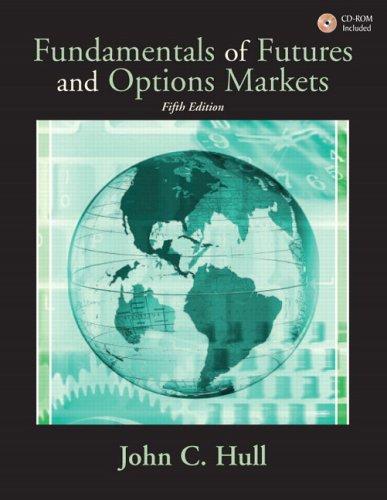Answered step by step
Verified Expert Solution
Question
1 Approved Answer
Make a review about this article that include: 1. An explanation of the value judgment used by the author and the recommendations given by the
Make a review about this article that include:
1. An explanation of the value judgment used by the author and the recommendations given by the author based on the value judgment he put forward.
2. Make a critical review about this article
1000 words maximal
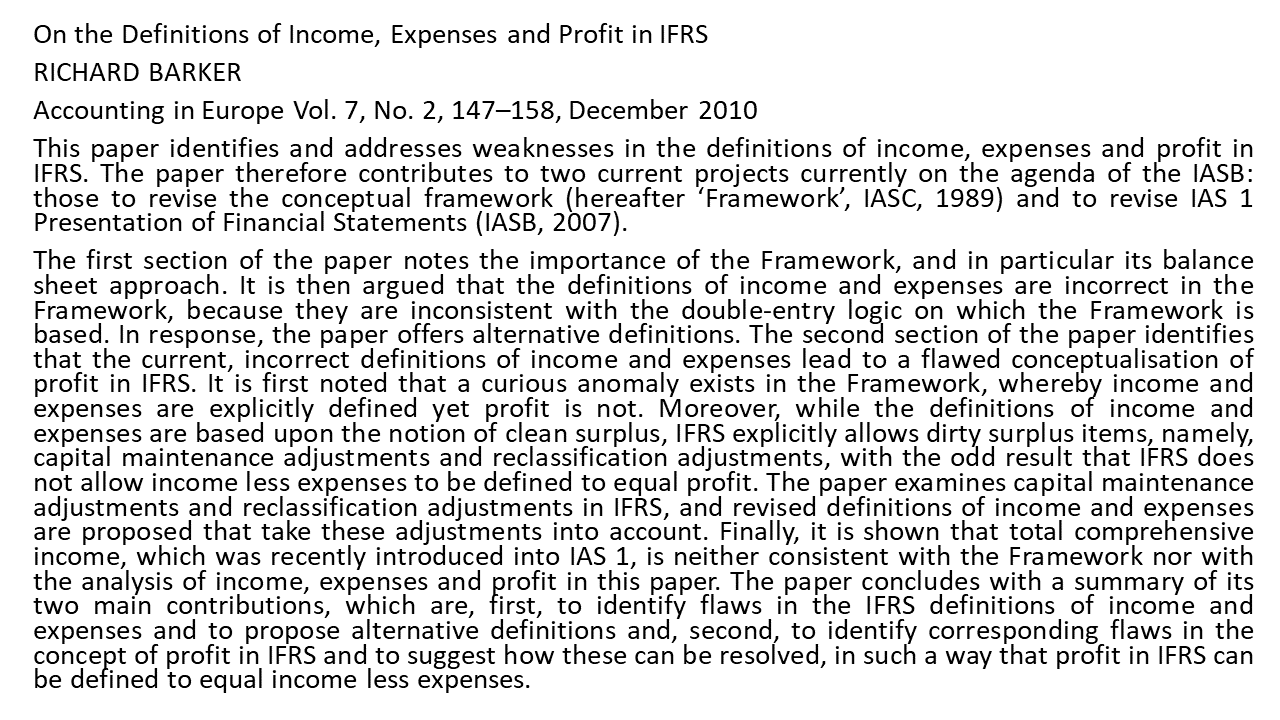
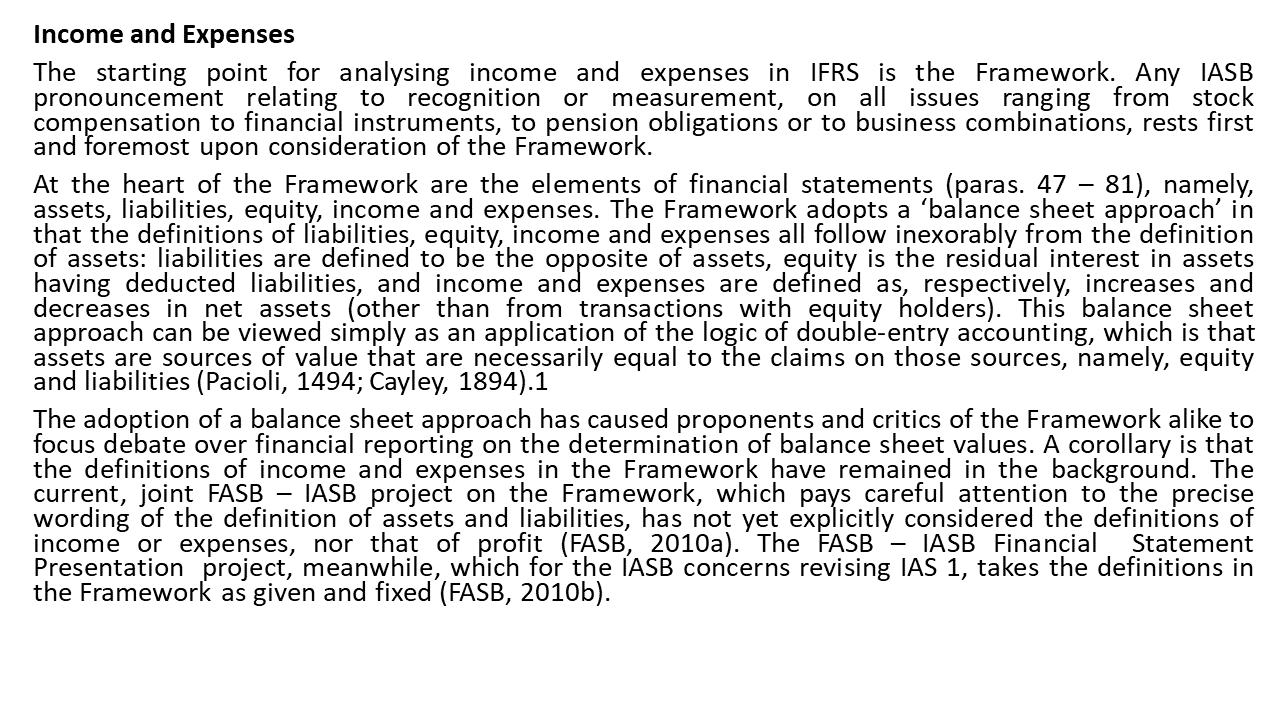
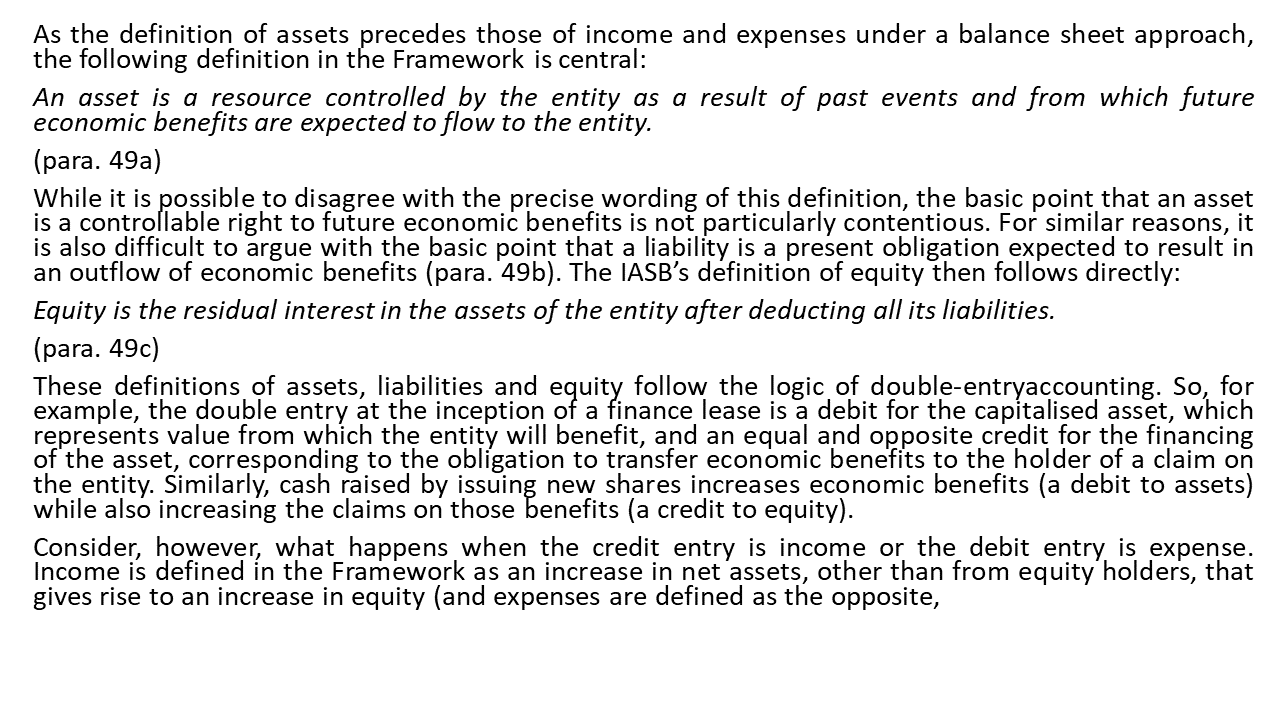
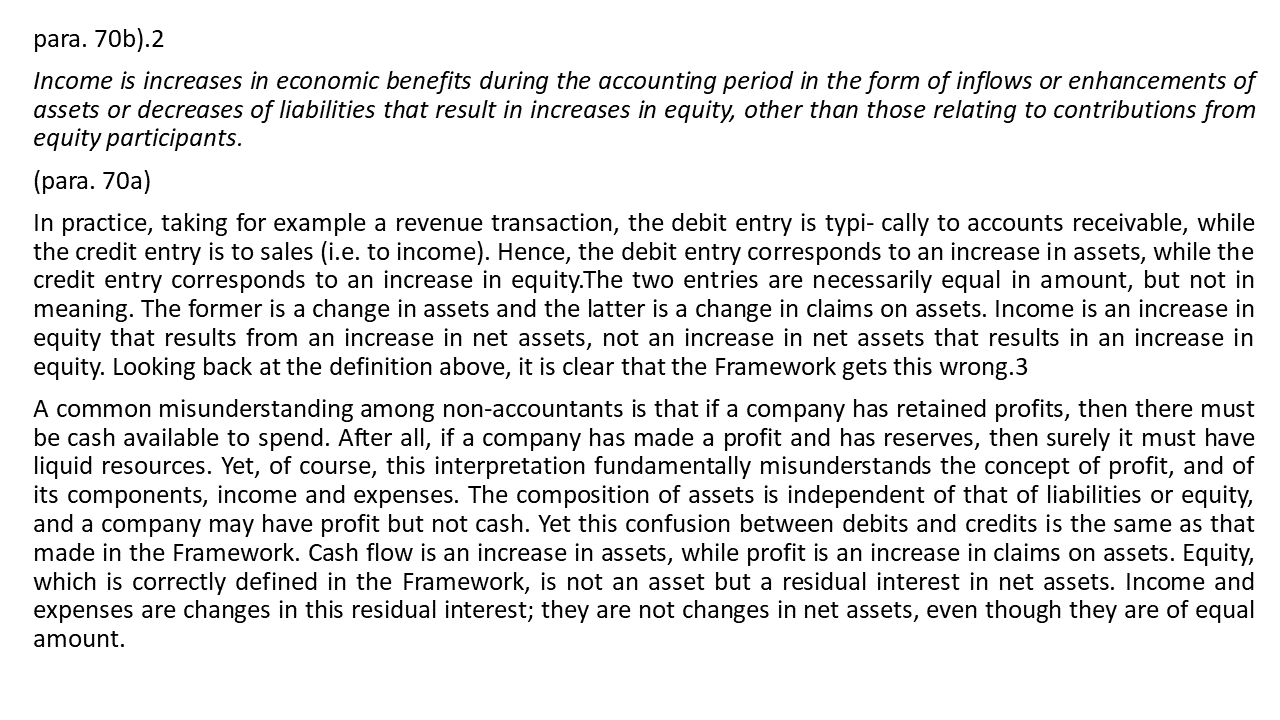
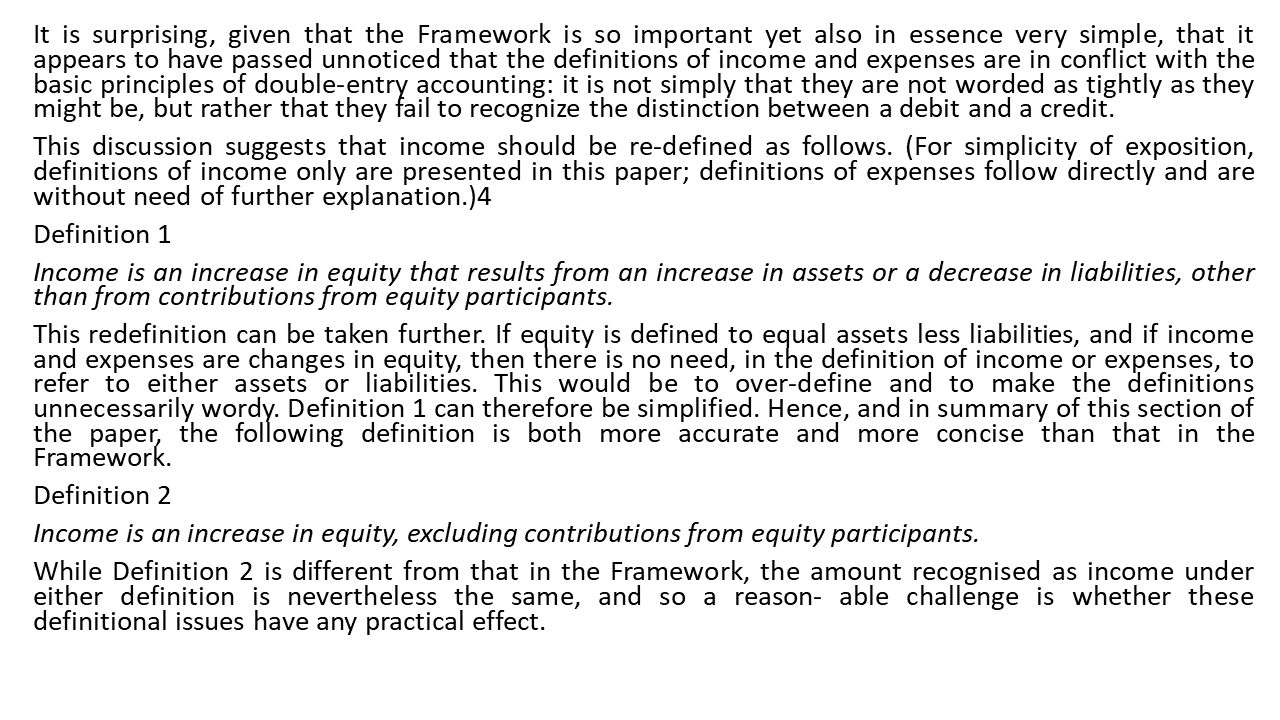
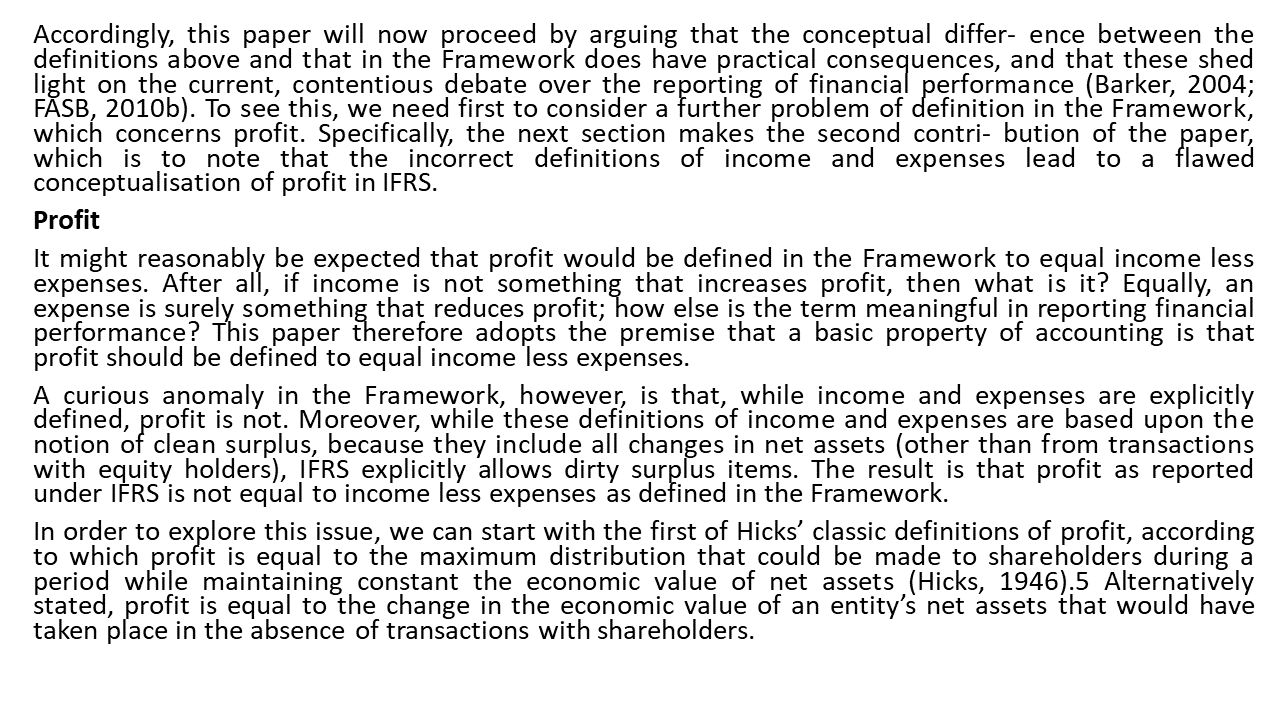
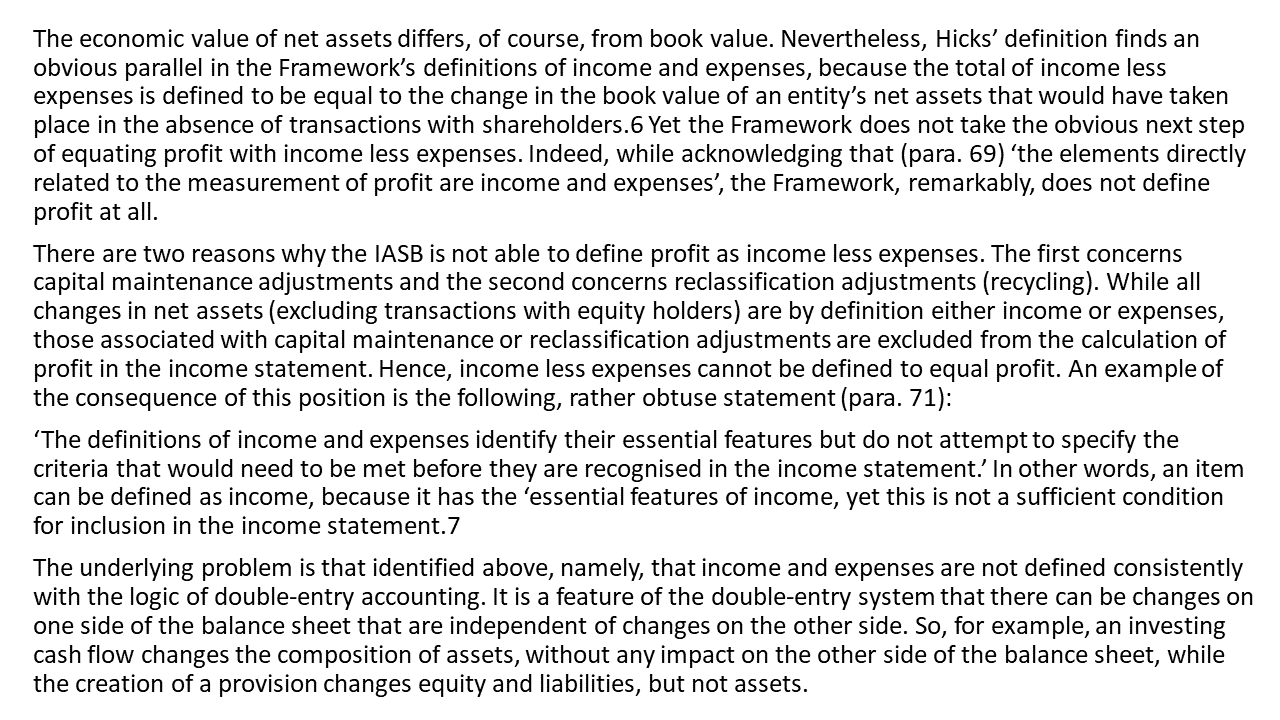
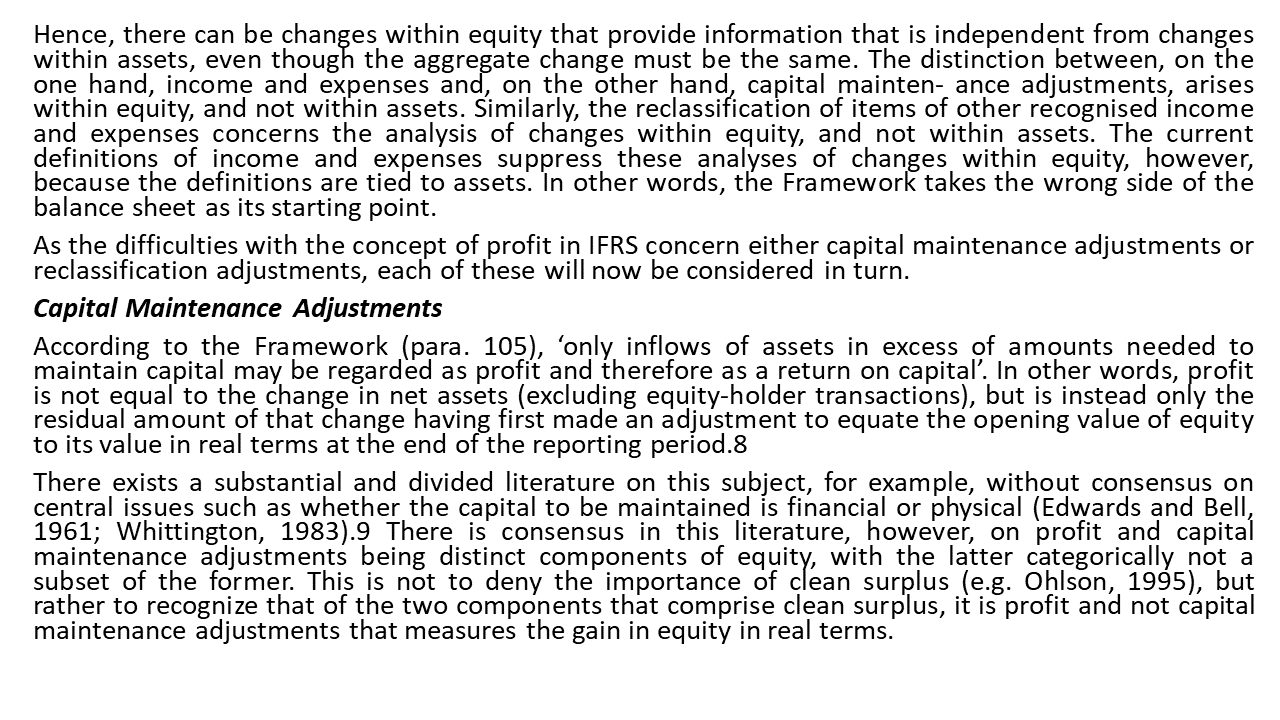
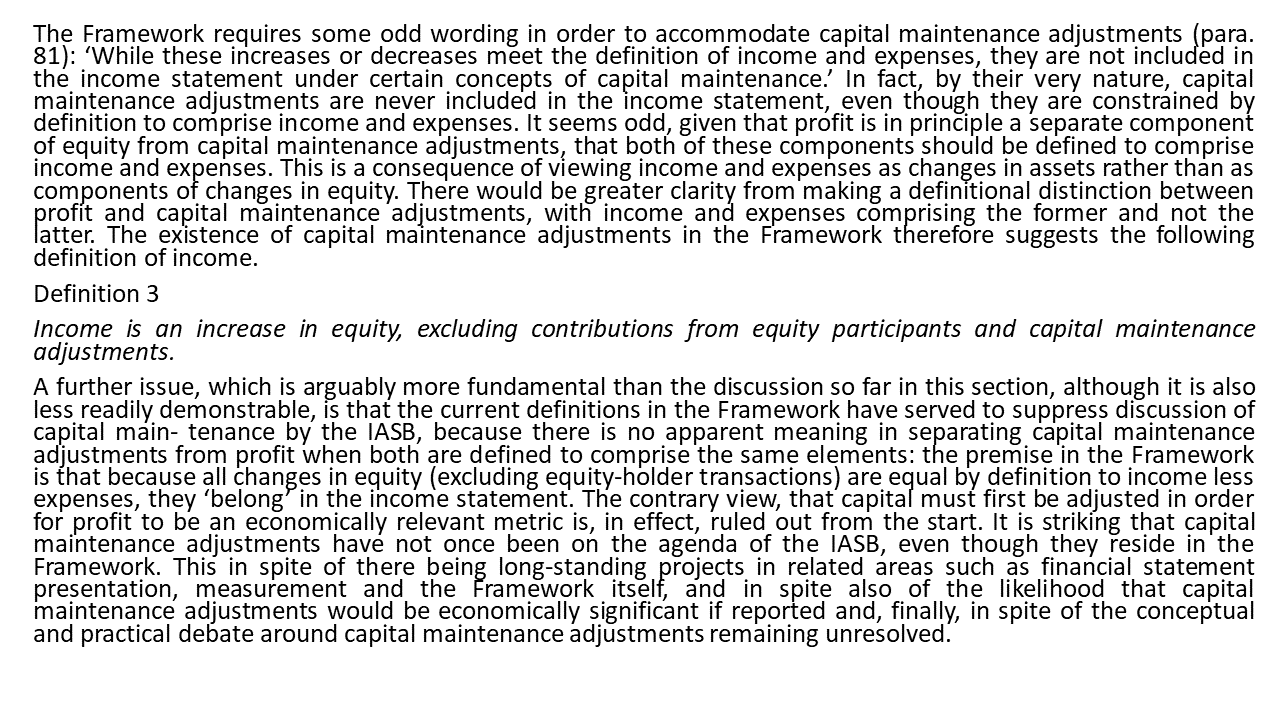
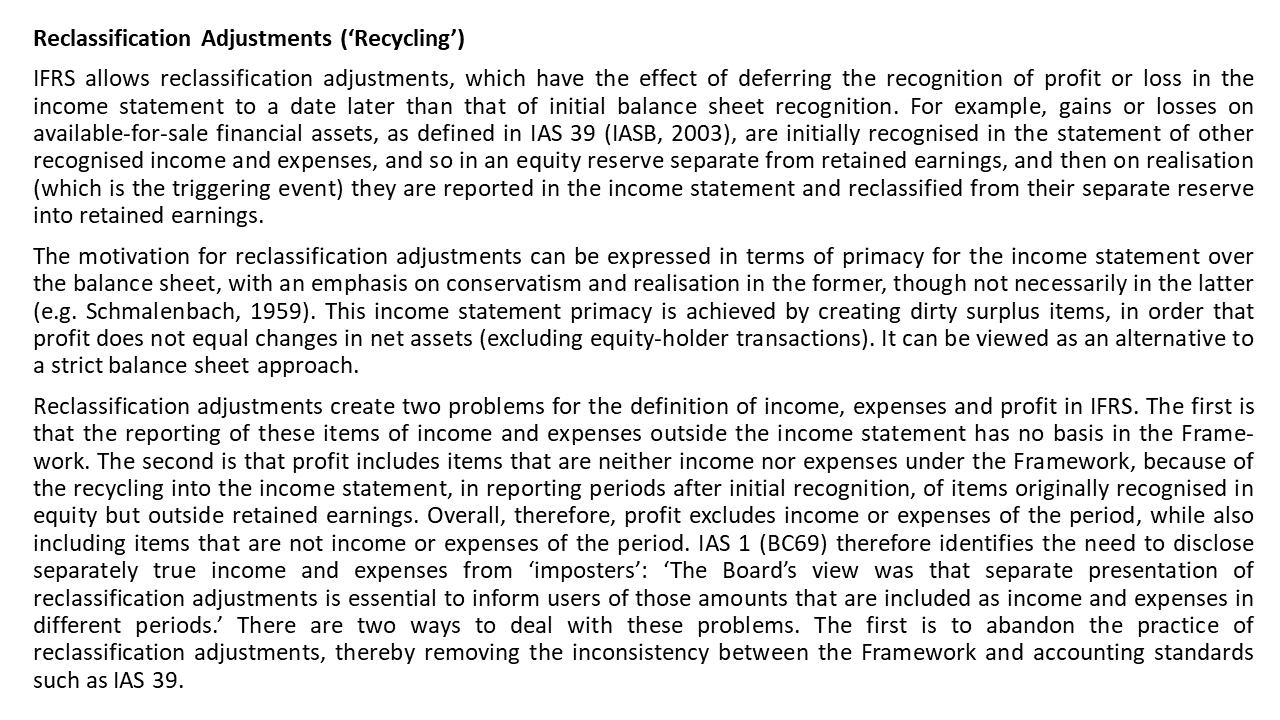
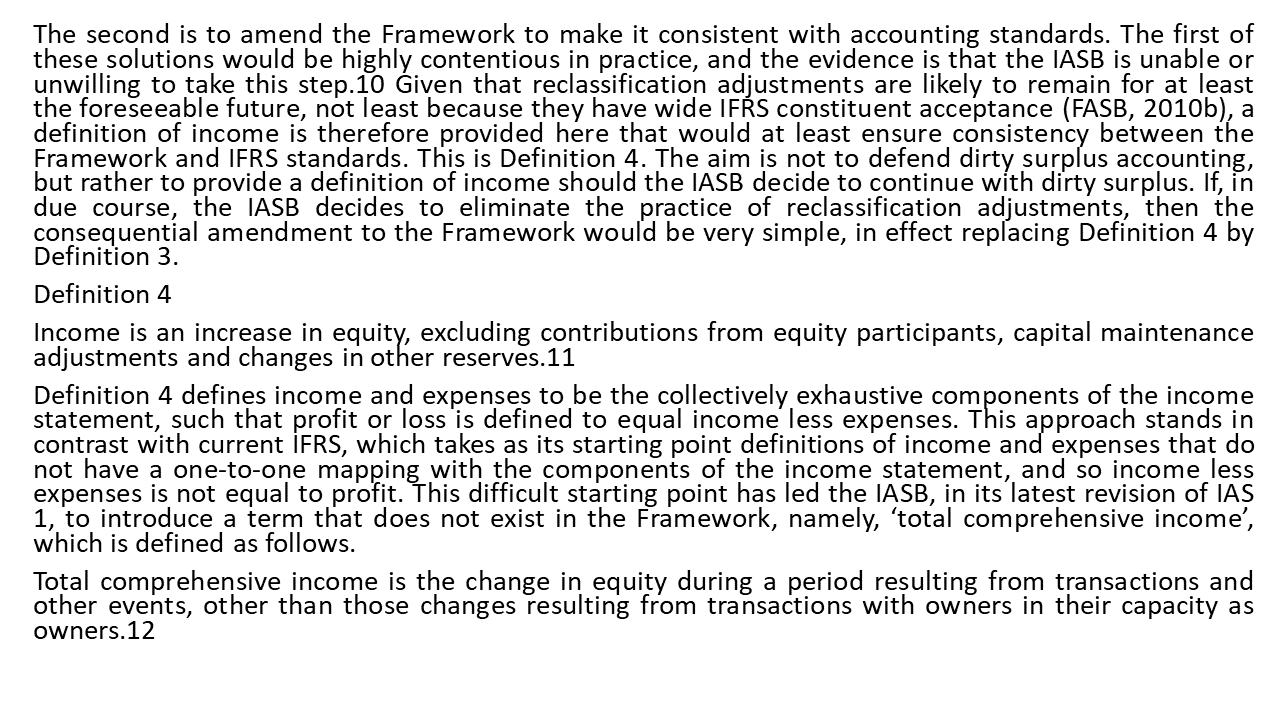
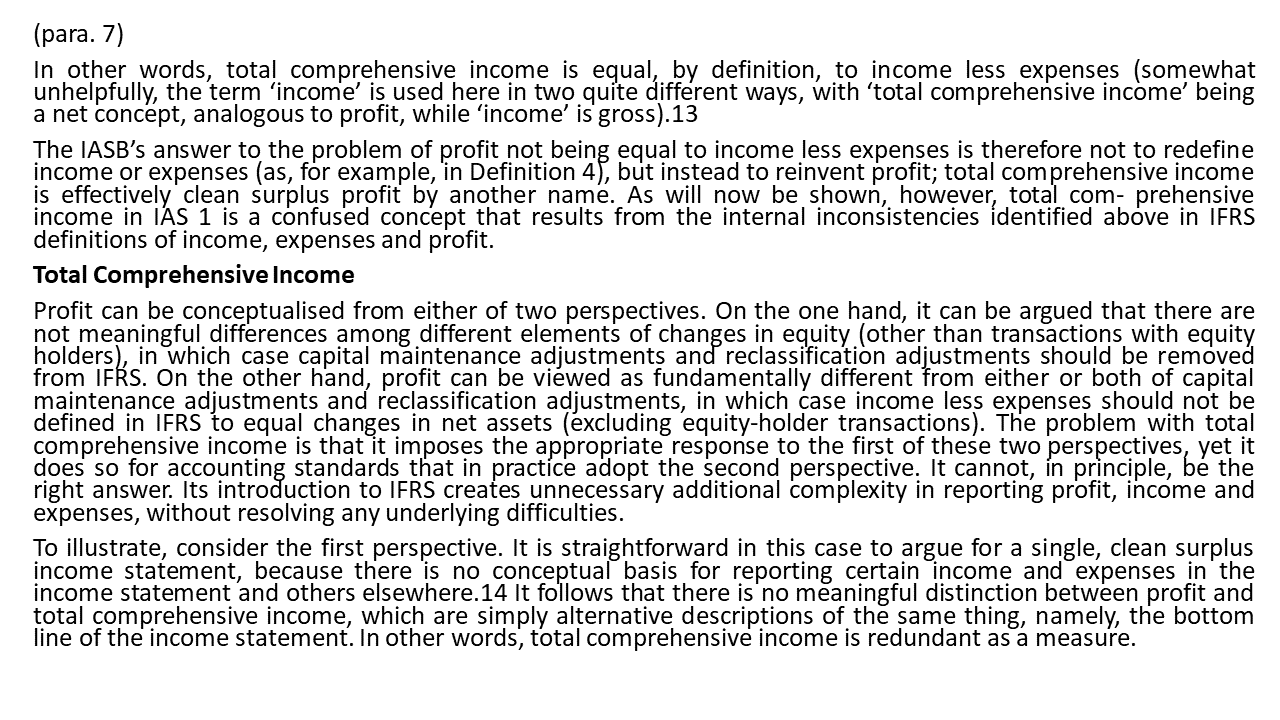
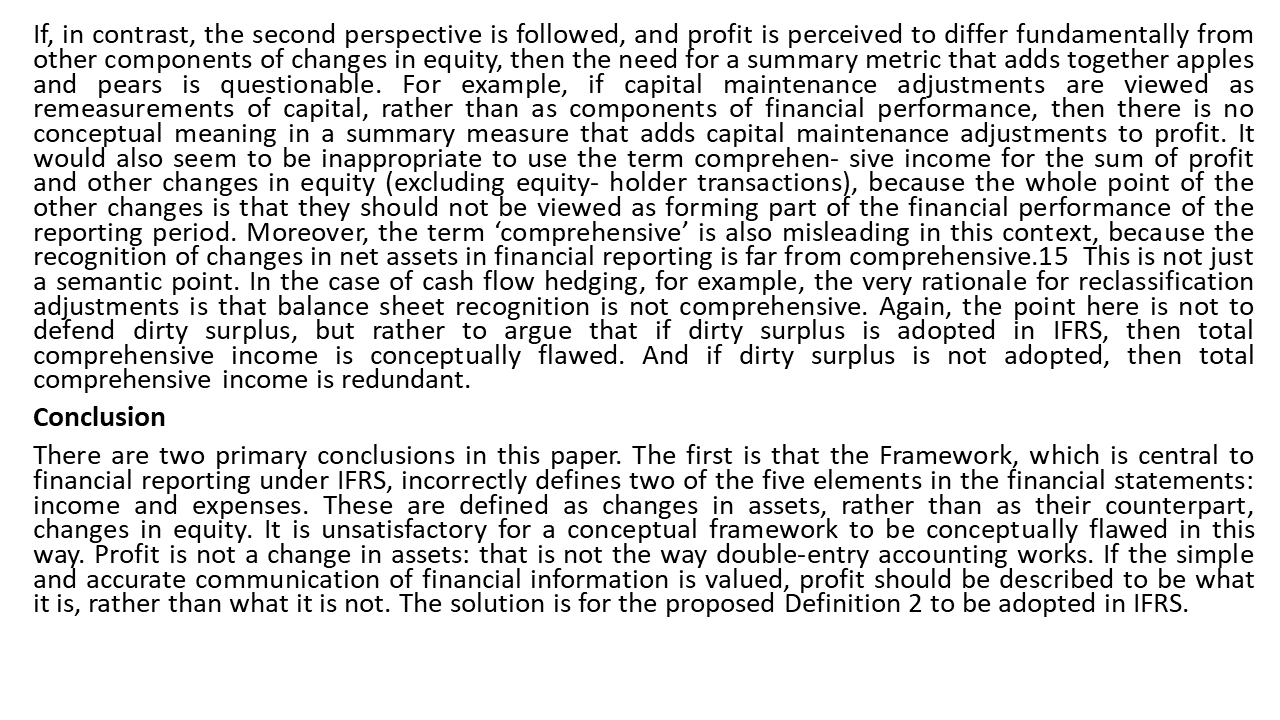
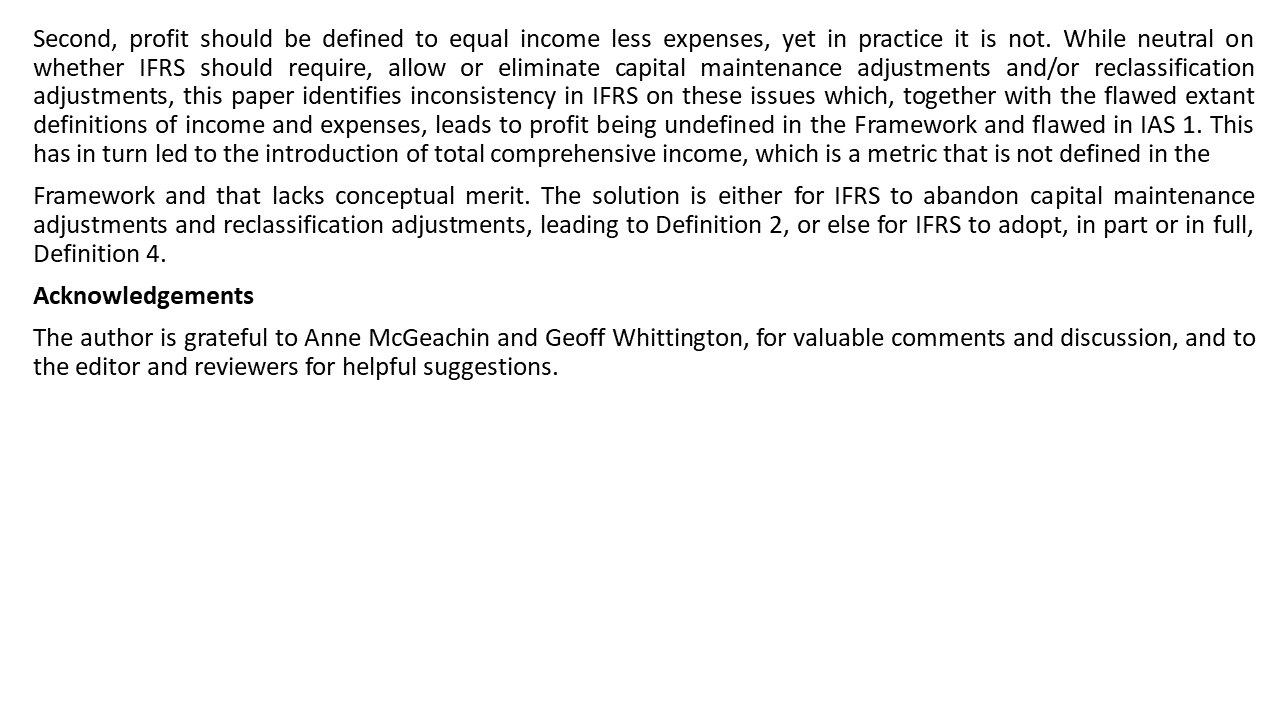
Make a review about this article that include:
1. An explanation of the value judgment used by the author and the recommendations given by the author based on the value judgment he put forward.
2. Make a critical review about this article
1000 words maximal
On the Definitions of Income, Expenses and Profit in IFRS RICHARD BARKER Accounting in Europe Vol. 7, No. 2, 147158, December 2010 This paper identifies and addresses weaknesses in the definitions of income, expenses and profit in IFRS. The paper therefore contributes to two current projects currently on the agenda of the IASB: those to revise the conceptual framework (hereafter 'Framework', IASC, 1989) and to revise IAS 1 Presentation of Financial Statements (IASB, 2007). The first section of the paper notes the importance of the Framework, and in particular its balance sheet approach. It is then argued that the definitions of income and expenses are incorrect in the Framework, because they are inconsistent with the double-entry logic on which the Framework is based. In response, the paper offers alternative definitions. The second section of the paper identifies that the current, incorrect definitions of income and expenses lead to a flawed conceptualisation of profit in IFRS. It is first noted that a curious anomaly exists in the Framework, whereby income and expenses are explicitly defined yet profit is not. Moreover, while the definitions of income and expenses are based upon the notion of clean surplus, IFRS explicitly allows dirty surplus items, namely, capital maintenance adjustments and reclassification adjustments, with the odd result that IFRS does not allow income less expenses to be defined to equal profit. The paper examines capital maintenance adjustments and reclassification adjustments in IFRS, and revised definitions of income and expenses are proposed that take these adjustments into account. Finally, it is shown that total comprehensive income, which was recently introduced into IAS 1, is neither consistent with the Framework nor with the analysis of income, expenses and profit in this paper. The paper concludes with a summary of its two main contributions, which are, first, to identify flaws in the IFRS definitions of income and expenses and to propose alternative definitions and, second, to identify corresponding flaws in the concept of profit in IFRS and to suggest how these can be resolved, in such a way that profit in IFRS can be defined to equal income less expenses. As the definition of assets precedes those of income and expenses under a balance sheet approach, the following definition in the Framework is central: An asset is a resource controlled by the entity as a result of past events and from which future economic benefits are expected to flow to the entity. (para. 49a) While it is possible to disagree with the precise wording of this definition, the basic point that an asset is a controllable right to future economic benefits is not particularly contentious. For similar reasons, it is also difficult to argue with the basic point that a liability is a present obligation expected to result in an outflow of economic benefits (para. 49b). The IASB's definition of equity then follows directly: Equity is the residual interest in the assets of the entity after deducting all its liabilities. (para. 49c) These definitions of assets, liabilities and equity follow the logic of double-entryaccounting. So, for example, the double entry at the inception of a finance lease is a debit for the capitalised asset, which represents value from which the entity will benefit, and an equal and opposite credit for the financing of the asset, corresponding to the obligation to transfer economic benefits to the holder of a claim on the entity. Similarly, cash raised by issuing new shares increases economic benefits (a debit to assets) while also increasing the claims on those benefits (a credit to equity). Consider, however, what happens when the credit entry is income or the debit entry, is expense. Income is defined in the Framework as an increase in net assets, other than from equity holders, that gives rise to an increase in equity (and expenses are defined as the opposite, para. 70b).2 Income is increases in economic benefits during the accounting period in the form of inflows or enhancements of assets or decreases of liabilities that result in increases in equity, other than those relating to contributions from equity participants. (para. 70a) In practice, taking for example a revenue transaction, the debit entry is typi- cally to accounts receivable, while the credit entry is to sales (i.e. to income). Hence, the debit entry corresponds to an increase in assets, while the credit entry corresponds to an increase in equity.The two entries are necessarily equal in amount, but not in meaning. The former is a change in assets and the latter is a change in claims on assets. Income is an increase in equity that results from an increase in net assets, not an increase in net assets that results in an increase in equity. Looking back at the definition above, it is clear that the Framework gets this wrong.3 A common misunderstanding among non-accountants is that if a company has retained profits, then there must be cash available to spend. After all, if a company has made a profit and has reserves, then surely it must have liquid resources. Yet, of course, this interpretation fundamentally misunderstands the concept of profit, and of its components, income and expenses. The composition of assets is independent of that of liabilities or equity, and a company may have profit but not cash. Yet this confusion between debits and credits is the same as that made in the Framework. Cash flow is an increase in assets, while profit is an increase in claims on assets. Equity, which is correctly defined in the Framework, is not an asset but a residual interest in net assets. Income and expenses are changes in this residual interest; they are not changes in net assets, even though they are of equal amount. It is surprising, given that the Framework is so important yet also in essence very simple, that it appears to have passed unnoticed that the definitions of income and expenses are in conflict with the basic principles of double-entry accounting: it is not simply that they are not worded as tightly as they might be, but rather that they fail to recognize the distinction between a debit and a credit. This discussion suggests that income should be re-defined as follows. (For simplicity of exposition, definitions of income only are presented in this paper; definitions of expenses follow directly and are without need of further explanation.)4 Definition 1 Income is an increase in equity that results from an increase in assets or a decrease in liabilities, other than from contributions from equity participants. This redefinition can be taken further. If equity is defined to equal assets less liabilities, and if income and expenses are changes in equity, then there is no need, in the definition of income or expenses, to refer to either assets or liabilities. This would be to over-define and to make the definitions unnecessarily wordy. Definition 1 can therefore be simplified. Hence, and in summary of this section of the paper, the following definition is both more accurate and more concise than that in the Framework. Definition 2 Income is an increase in equity, excluding contributions from equity participants. While Definition 2 is different from that in the Framework, the amount recognised as income under either definition is nevertheless the same, and so a reason- able challenge is whether these definitional issues have any practical effect. Accordingly, this paper will now proceed by arguing that the conceptual differ- ence between the definitions above and that in the Framework does have practical consequences, and that these shed light on the current, contentious debate over the reporting of financial performance (Barker, 2004; FSB, 2010b). To see this, we need first to consider a further problem of definition in the Framework, which concerns profit. Specifically, the next section makes the second contri- bution of the paper, which is to note that the incorrect definitions of income and expenses lead to a flawed conceptualisation of profit in IFRS. Profit It might reasonably be expected that profit would be defined in the Framework to equal income less expenses. After all, if income is not something that increases profit, then what is it? Equally, an expense is surely something that reduces profit; how else is the term meaningful in reporting financial performance? This paper therefore adopts the premise that a basic property of accounting is that profit should be defined to equal income less expenses. A curious anomaly in the Framework, however, is that, while income and expenses are explicitly defined, profit is not. Moreover, while these definitions of income and expenses are based upon the notion of clean surplus, because they include all changes in net assets (other than from transactions with equity holders), IFRS explicitly allows dirty surplus items. The result is that profit as reported under IFRS is not equal to income less expenses as defined in the Framework. In order to explore this issue, we can start with the first of Hicks' classic definitions of profit, according to which profit is equal to the maximum distribution that could be made to shareholders during a period while maintaining constant the economic value of net assets (Hicks, 1946),5 Alternatively stated, profit is equal to the change in the economic value of an entity's net assets that would have taken place in the absence of transactions with shareholders. The economic value of net assets differs, of course, from book value. Nevertheless, Hicks' definition finds an obvious parallel in the Framework's definitions of income and expenses, because the total of income less expenses is defined to be equal to the change in the book value of an entity's net assets that would have taken place in the absence of transactions with shareholders.6 Yet the Framework does not take the obvious next step of equating profit with income less expenses. Indeed, while acknowledging that (para. 69) the elements directly related to the measurement of profit are income and expenses', the Framework, remarkably, does not define profit at all. There are two reasons why the IASB is not able to define profit as income less expenses. The first concerns capital maintenance adjustments and the second concerns reclassification adjustments (recycling). While all changes in net assets (excluding transactions with equity holders) are by definition either income or expenses, those associated with capital maintenance or reclassification adjustments are excluded from the calculation of profit in the income statement. Hence, income less expenses cannot be defined to equal profit. An example of the consequence of this position is the following, rather obtuse statement (para. 71): 'The definitions of income and expenses identify their essential features but do not attempt to specify the criteria that would need to be met before they are recognised in the income statement. In other words, an item can be defined as income, because it has the 'essential features of income, yet this is not a sufficient condition for inclusion in the income statement.7 The underlying problem is that identified above, namely, that income and expenses are not defined consistently with the logic of double-entry accounting. It is a feature of the double-entry system that there can be changes on one side of the balance sheet that are independent of changes on the other side. So, for example, an investing cash flow changes the composition of assets, without any impact on the other side of the balance sheet, while the creation of a provision changes equity and liabilities, but not assets. Hence, there can be changes within equity that provide information that is independent from changes within assets, even though the aggregate change must be the same. The distinction between, on the one hand, income and expenses and, on the other hand, capital mainten- ance adjustments, arises within equity, and not within assets. Similarly, the reclassification of items of other recognised income and expenses concerns the analysis of changes within equity, and not within assets. The current definitions of income and expenses suppress these analyses of changes within equity, however, because the definitions are tied to assets. In other words, the Framework takes the wrong side of the balance sheet as its starting point. As the difficulties with the concept of profit in IFRS concern either capital maintenance adjustments or reclassification adjustments, each of these will now be considered in turn. Capital Maintenance Adjustments According to the Framework (para. 105), 'only inflows of assets in excess of amounts needed to maintain capital may be regarded as profit and therefore as a return on capital. In other words, profit is not equal to the change in net assets (excluding equity-holder transactions), but is instead only the residual amount of that change having first made an adjustment to equate the opening value of equity to its value in real terms at the end of the reporting period.8 There exists a substantial and divided literature on this subject, for example, without consensus on central issues such as whether the capital to be maintained is financial or physical (Edwards and Bell, 1961; Whittington, 1983).9 There is consensus in this literature, however, on profit and capital maintenance adjustments being distinct components of equity, with the latter categorically not a subset of the former. This is not to deny the importance of clean surplus (e.g. Ohlson, 1995), but rather to recognize that of the two components that comprise clean surplus, it is profit and not capital maintenance adjustments that measures the gain in equity in real terms. The Framework requires some odd wording in order to accommodate capital maintenance adjustments (para. 81): 'While these increases or decreases meet the definition of income and expenses, they are not included in the income statement under certain concepts of capital maintenance! In fact, by their very nature, capital maintenance adjustments are never included in the income statement, even though they are constrained by definition to comprise income and expenses. It seems odd, given that profit is in principle a separate component of equity from capital maintenance adjustments, tht both of these components should be defined to comprise income and expenses. This is a consequence of viewing income and expenses as changes in assets rather than as components of changes in equity. There would be greater clarity from making a definitional distinction between profit and capital maintenance adjustments, with income, and expenses comprising the former and not the latter. The existence of capital maintenance adjustments in the Framework therefore suggests the following definition of income. Definition 3 Income is an increase in equity, excluding contributions from equity participants and capital maintenance adjustments. A further issue, which is arguably more fundamental than the discussion so far in this section, although it is also less readily demonstrable, is that the current definitions in the Framework have served to suppress discussion of capital main- tenance by the IASB, because there is no apparent meaning in separating, capital maintenance adjustments from profit when both are defined to comprise the same elements: the premise in the Framework is that because all changes in equity (excluding equity-holder transactions) are equal by definition to income less expenses, they belong in the income statement. The contrary view, that capital must first be adjusted in order for profit to be an economically relevant metric is, in effect, ruled out from the start. It is striking that capital maintenance adjustments have not once been on the agenda of the IASB, even though they reside in the Framework. This in spite of there being long-standing projects in related areas such as financial statement presentation, measurement and the framework itself, and in spite also of the likelihood that capital maintenance adjustments would be economically significant if reported and, finally, in spite of the conceptual and practical debate around capital maintenance adjustments remaining unresolved. Reclassification Adjustments ('Recycling') IFRS allows reclassification adjustments, which have the effect of deferring the recognition of profit or loss in the income statement to a date later than that of initial balance sheet recognition. For example, gains or losses on available-for-sale financial assets, as defined in IAS 39 (IASB, 2003), are initially recognised in the statement of other recognised income and expenses, and so in an equity reserve separate from retained earnings, and then on realisation (which is the triggering event) they are reported in the income statement and reclassified from their separate reserve into retained earnings. The motivation for reclassification adjustments can be expressed in terms of primacy for the income statement over the balance sheet, with an emphasis on conservatism and realisation in the former, though not necessarily in the latter (e.g. Schmalenbach, 1959). This income statement primacy is achieved by creating dirty surplus items, in order that profit does not equal changes in net assets (excluding equity-holder transactions). It can be viewed as an alternative to a strict balance sheet approach. Reclassification adjustments create two problems for the definition of income, expenses and profit in IFRS. The first is that the reporting of these items of income and expenses outside the income statement has no basis in the Frame- work. The second is that profit includes items that are neither income nor expenses under the Framework, because of the recycling into the income statement, in reporting periods after initial recognition, of items originally recognised in equity but outside retained earnings. Overall, therefore, profit excludes income or expenses of the period, while also including items that are not income or expenses of the period. IAS 1 (BC69) therefore identifies the need to disclose separately true income and expenses from 'imposters': 'The Board's view was that separate presentation of reclassification adjustments is essential to inform users of those amounts that are included as income and expenses in different periods. There are two ways to deal with these problems. The first is to abandon the practice of reclassification adjustments, thereby removing the inconsistency between the Framework and accounting standards such as IAS 39. The second is to amend the Framework to make it consistent with accounting standards. The first of these solutions would be highly contentious in practice, and the evidence is that the IASB is unable or unwilling to take this step.10 Given that reclassification adjustments are likely to remain for at least the foreseeable future, not least because they have wide IFRS constituent acceptance (FASB, 2010b), a definition of income is therefore provided here that would at least ensure consistency between the Framework and IFRS standards. This is Definition 4. The aim is not to defend dirty surplus accounting, but rather to provide a definition of income should the IASB decide to continue with dirty surplus. If, in due course, the IASB decides to eliminate the practice of reclassification adjustments, then the consequential amendment to the Framework would be very simple, in effect replacing Definition 4 by Definition 3. Definition 4 Income is an increase in equity, excluding contributions from equity participants, capital maintenance adjustments and changes in other reserves.11 Definition 4 defines income and expenses to be the collectively exhaustive components of the income statement, such that profit or loss is defined to equal income less expenses. This approach stands in contrast with current FRS, which takes as its starting point definitions of income and expenses that do not have a one-to-one mapping with the components of the income statement, and so income less expenses is not equal to profit. This difficult starting point has led the IASB, in its latest revision of IAS 1, to introduce a term that does not exist in the Framework, namely, 'total comprehensive income', which is defined as follows. Total comprehensive income is the change in equity during a period resulting from transactions and other events, other than those changes resulting from transactions with owners in their capacity as owners.12 (para. 7) In other words, total comprehensive income is equal, by definition, to income less expenses (somewhat unhelpfully, the term 'income' is used here in two. quite different ways, with 'total comprehensive income' being a net concept, analogous to profit, while 'income' is gross).13 The IASB's answer to the problem of profit not being equal to income less expenses is therefore not to redefine income or expenses (as, for example, 'in Definition 4), but instead to reinvent profit; total comprehensive income is effectively clean surplus profit by another name. As will now be shown, however, total com- prehensive income in IAS 1 is a confused concept that results from the internal inconsistencies identified above in IFRS definitions of income, expenses and profit. Total Comprehensive Income Profit can be conceptualised from either of two perspectives. On the one hand, it can be argued that there are not meaningful differences among different elements of changes in equity (other than transactions with equity holders), in which case capital maintenance adjustments and reclassification adjustments should be removed from IFRS. On the other hand, profit can be viewed as fundamentally different from either or both of capital maintenance adjustments and reclassification adjustments, in which case income less expenses should not be defined in IFRS to equal changes in net assets (excluding equity-holder transactions). The problem with total comprehensive income is that it imposes the appropriate response to the first of these two perspectives, yet it does so for accounting standards that in practice adopt the second perspective. It cannot, in principle, b the right answer. Its introduction to IFRS creates unnecessary additional complexity in reporting profit, income and expenses, without resolving any underlying difficulties. To illustrate, consider the first perspective. It is straightforward in this case to argue for a single, clean surplus income statement, because there is no conceptual basis for reporting certain income and expenses in the income statement and others elsewhere.14 It follows that there is no meaningful distinction between profit and total comprehensive income, which are simply alternative descriptions of the same thing, namely, the bottom line of the income statement. In other words, total comprehensive income is redundant as a measure. If, in contrast, the second perspective is followed, and profit is perceived to differ fundamentally from other components of changes in equity, then the need for a summary metric that adds together apples and pears is questionable. For example, if capital maintenance adjustments are viewed as remeasurements of capital, rather than as components of financial performance, then there is no conceptual meaning in a summary measure that adds capital maintenance adjustments to profit. It would also seem to be inappropriate to use the term comprehen- sive income for the sum of profit and other changes in equity (excluding equity- holder transactions), because the whole point of the other changes is that they should not be viewed as forming part of the financial performance of the reporting period. Moreover, the term comprehensive' is also misleading in this context, because the recognition of changes in net assets in financial reporting is far from comprehensive.15 This is not just a semantic point. In the case of cash flow hedging, for example, the very rationale for reclassification adjustments is that balance sheet recognition is not comprehensive. Again, the point here is not to defend dirty surplus, but rather to argue that if dirty surplus is adopted in IFRS, then total comprehensive income is conceptually flawed. And if dirty surplus is not adopted, then total comprehensive income is redundant. Conclusion There are two primary conclusions in this paper. The first is that the Framework, which is central to financial reporting under IFRS, incorrectly defines two of the five elements in the financial statements: income and expenses. These are defined as changes in assets, rather than as their counterpart, changes in equity. It is unsatisfactory for a conceptual framework to be conceptually flawed in this way. Profit is not a change in assets: that is not the way double-entry accounting works. If the simple and accurate communication of financial information is valued, profit should be described to be what it is, rather than what it is not. The solution is for the proposed Definition 2 to be adopted in IFRS. Second, profit should be defined to equal income less expenses, yet in practice it is not. While neutral on whether IFRS should require, allow or eliminate capital maintenance adjustments and/or reclassification adjustments, this paper identifies inconsistency in IFRS on these issues which, together with the flawed extant definitions of income and expenses, leads to profit being undefined in the Framework and flawed in IAS 1. This has in turn led to the introduction of total comprehensive income, which is a metric that is not defined in the Framework and that lacks conceptual merit. The solution is either for IFRS to abandon capital maintenance adjustments and reclassification adjustments, leading to Definition 2, or else for IFRS to adopt, in part or in full, Definition 4. Acknowledgements The author is grateful to Anne McGeachin and Geoff Whittington, for valuable comments and discussion, and to the editor and reviewers for helpful suggestions. On the Definitions of Income, Expenses and Profit in IFRS RICHARD BARKER Accounting in Europe Vol. 7, No. 2, 147158, December 2010 This paper identifies and addresses weaknesses in the definitions of income, expenses and profit in IFRS. The paper therefore contributes to two current projects currently on the agenda of the IASB: those to revise the conceptual framework (hereafter 'Framework', IASC, 1989) and to revise IAS 1 Presentation of Financial Statements (IASB, 2007). The first section of the paper notes the importance of the Framework, and in particular its balance sheet approach. It is then argued that the definitions of income and expenses are incorrect in the Framework, because they are inconsistent with the double-entry logic on which the Framework is based. In response, the paper offers alternative definitions. The second section of the paper identifies that the current, incorrect definitions of income and expenses lead to a flawed conceptualisation of profit in IFRS. It is first noted that a curious anomaly exists in the Framework, whereby income and expenses are explicitly defined yet profit is not. Moreover, while the definitions of income and expenses are based upon the notion of clean surplus, IFRS explicitly allows dirty surplus items, namely, capital maintenance adjustments and reclassification adjustments, with the odd result that IFRS does not allow income less expenses to be defined to equal profit. The paper examines capital maintenance adjustments and reclassification adjustments in IFRS, and revised definitions of income and expenses are proposed that take these adjustments into account. Finally, it is shown that total comprehensive income, which was recently introduced into IAS 1, is neither consistent with the Framework nor with the analysis of income, expenses and profit in this paper. The paper concludes with a summary of its two main contributions, which are, first, to identify flaws in the IFRS definitions of income and expenses and to propose alternative definitions and, second, to identify corresponding flaws in the concept of profit in IFRS and to suggest how these can be resolved, in such a way that profit in IFRS can be defined to equal income less expenses. As the definition of assets precedes those of income and expenses under a balance sheet approach, the following definition in the Framework is central: An asset is a resource controlled by the entity as a result of past events and from which future economic benefits are expected to flow to the entity. (para. 49a) While it is possible to disagree with the precise wording of this definition, the basic point that an asset is a controllable right to future economic benefits is not particularly contentious. For similar reasons, it is also difficult to argue with the basic point that a liability is a present obligation expected to result in an outflow of economic benefits (para. 49b). The IASB's definition of equity then follows directly: Equity is the residual interest in the assets of the entity after deducting all its liabilities. (para. 49c) These definitions of assets, liabilities and equity follow the logic of double-entryaccounting. So, for example, the double entry at the inception of a finance lease is a debit for the capitalised asset, which represents value from which the entity will benefit, and an equal and opposite credit for the financing of the asset, corresponding to the obligation to transfer economic benefits to the holder of a claim on the entity. Similarly, cash raised by issuing new shares increases economic benefits (a debit to assets) while also increasing the claims on those benefits (a credit to equity). Consider, however, what happens when the credit entry is income or the debit entry, is expense. Income is defined in the Framework as an increase in net assets, other than from equity holders, that gives rise to an increase in equity (and expenses are defined as the opposite, para. 70b).2 Income is increases in economic benefits during the accounting period in the form of inflows or enhancements of assets or decreases of liabilities that result in increases in equity, other than those relating to contributions from equity participants. (para. 70a) In practice, taking for example a revenue transaction, the debit entry is typi- cally to accounts receivable, while the credit entry is to sales (i.e. to income). Hence, the debit entry corresponds to an increase in assets, while the credit entry corresponds to an increase in equity.The two entries are necessarily equal in amount, but not in meaning. The former is a change in assets and the latter is a change in claims on assets. Income is an increase in equity that results from an increase in net assets, not an increase in net assets that results in an increase in equity. Looking back at the definition above, it is clear that the Framework gets this wrong.3 A common misunderstanding among non-accountants is that if a company has retained profits, then there must be cash available to spend. After all, if a company has made a profit and has reserves, then surely it must have liquid resources. Yet, of course, this interpretation fundamentally misunderstands the concept of profit, and of its components, income and expenses. The composition of assets is independent of that of liabilities or equity, and a company may have profit but not cash. Yet this confusion between debits and credits is the same as that made in the Framework. Cash flow is an increase in assets, while profit is an increase in claims on assets. Equity, which is correctly defined in the Framework, is not an asset but a residual interest in net assets. Income and expenses are changes in this residual interest; they are not changes in net assets, even though they are of equal amount. It is surprising, given that the Framework is so important yet also in essence very simple, that it appears to have passed unnoticed that the definitions of income and expenses are in conflict with the basic principles of double-entry accounting: it is not simply that they are not worded as tightly as they might be, but rather that they fail to recognize the distinction between a debit and a credit. This discussion suggests that income should be re-defined as follows. (For simplicity of exposition, definitions of income only are presented in this paper; definitions of expenses follow directly and are without need of further explanation.)4 Definition 1 Income is an increase in equity that results from an increase in assets or a decrease in liabilities, other than from contributions from equity participants. This redefinition can be taken further. If equity is defined to equal assets less liabilities, and if income and expenses are changes in equity, then there is no need, in the definition of income or expenses, to refer to either assets or liabilities. This would be to over-define and to make the definitions unnecessarily wordy. Definition 1 can therefore be simplified. Hence, and in summary of this section of the paper, the following definition is both more accurate and more concise than that in the Framework. Definition 2 Income is an increase in equity, excluding contributions from equity participants. While Definition 2 is different from that in the Framework, the amount recognised as income under either definition is nevertheless the same, and so a reason- able challenge is whether these definitional issues have any practical effect. Accordingly, this paper will now proceed by arguing that the conceptual differ- ence between the definitions above and that in the Framework does have practical consequences, and that these shed light on the current, contentious debate over the reporting of financial performance (Barker, 2004; FSB, 2010b). To see this, we need first to consider a further problem of definition in the Framework, which concerns profit. Specifically, the next section makes the second contri- bution of the paper, which is to note that the incorrect definitions of income and expenses lead to a flawed conceptualisation of profit in IFRS. Profit It might reasonably be expected that profit would be defined in the Framework to equal income less expenses. After all, if income is not something that increases profit, then what is it? Equally, an expense is surely something that reduces profit; how else is the term meaningful in reporting financial performance? This paper therefore adopts the premise that a basic property of accounting is that profit should be defined to equal income less expenses. A curious anomaly in the Framework, however, is that, while income and expenses are explicitly defined, profit is not. Moreover, while these definitions of income and expenses are based upon the notion of clean surplus, because they include all changes in net assets (other than from transactions with equity holders), IFRS explicitly allows dirty surplus items. The result is that profit as reported under IFRS is not equal to income less expenses as defined in the Framework. In order to explore this issue, we can start with the first of Hicks' classic definitions of profit, according to which profit is equal to the maximum distribution that could be made to shareholders during a period while maintaining constant the economic value of net assets (Hicks, 1946),5 Alternatively stated, profit is equal to the change in the economic value of an entity's net assets that would have taken place in the absence of transactions with shareholders. The economic value of net assets differs, of course, from book value. Nevertheless, Hicks' definition finds an obvious parallel in the Framework's definitions of income and expenses, because the total of income less expenses is defined to be equal to the change in the book value of an entity's net assets that would have taken place in the absence of transactions with shareholders.6 Yet the Framework does not take the obvious next step of equating profit with income less expenses. Indeed, while acknowledging that (para. 69) the elements directly related to the measurement of profit are income and expenses', the Framework, remarkably, does not define profit at all. There are two reasons why the IASB is not able to define profit as income less expenses. The first concerns capital maintenance adjustments and the second concerns reclassification adjustments (recycling). While all changes in net assets (excluding transactions with equity holders) are by definition either income or expenses, those associated with capital maintenance or reclassification adjustments are excluded from the calculation of profit in the income statement. Hence, income less expenses cannot be defined to equal profit. An example of the consequence of this position is the following, rather obtuse statement (para. 71): 'The definitions of income and expenses identify their essential features but do not attempt to specify the criteria that would need to be met before they are recognised in the income statement. In other words, an item can be defined as income, because it has the 'essential features of income, yet this is not a sufficient condition for inclusion in the income statement.7 The underlying problem is that identified above, namely, that income and expenses are not defined consistently with the logic of double-entry accounting. It is a feature of the double-entry system that there can be changes on one side of the balance sheet that are independent of changes on the other side. So, for example, an investing cash flow changes the composition of assets, without any impact on the other side of the balance sheet, while the creation of a provision changes equity and liabilities, but not assets. Hence, there can be changes within equity that provide information that is independent from changes within assets, even though the aggregate change must be the same. The distinction between, on the one hand, income and expenses and, on the other hand, capital mainten- ance adjustments, arises within equity, and not within assets. Similarly, the reclassification of items of other recognised income and expenses concerns the analysis of changes within equity, and not within assets. The current definitions of income and expenses suppress these analyses of changes within equity, however, because the definitions are tied to assets. In other words, the Framework takes the wrong side of the balance sheet as its starting point. As the difficulties with the concept of profit in IFRS concern either capital maintenance adjustments or reclassification adjustments, each of these will now be considered in turn. Capital Maintenance Adjustments According to the Framework (para. 105), 'only inflows of assets in excess of amounts needed to maintain capital may be regarded as profit and therefore as a return on capital. In other words, profit is not equal to the change in net assets (excluding equity-holder transactions), but is instead only the residual amount of that change having first made an adjustment to equate the opening value of equity to its value in real terms at the end of the reporting period.8 There exists a substantial and divided literature on this subject, for example, without consensus on central issues such as whether the capital to be maintained is financial or physical (Edwards and Bell, 1961; Whittington, 1983).9 There is consensus in this literature, however, on profit and capital maintenance adjustments being distinct components of equity, with the latter categorically not a subset of the former. This is not to deny the importance of clean surplus (e.g. Ohlson, 1995), but rather to recognize that of the two components that comprise clean surplus, it is profit and not capital maintenance adjustments that measures the gain in equity in real terms. The Framework requires some odd wording in order to accommodate capital maintenance adjustments (para. 81): 'While these increases or decreases meet the definition of income and expenses, they are not included in the income statement under certain concepts of capital maintenance! In fact, by their very nature, capital maintenance adjustments are never included in the income statement, even though they are constrained by definition to comprise income and expenses. It seems odd, given that profit is in principle a separate component of equity from capital maintenance adjustments, tht both of these components should be defined to comprise income and expenses. This is a consequence of viewing income and expenses as changes in assets rather than as components of changes in equity. There would be greater clarity from making a definitional distinction between profit and capital maintenance adjustments, with income, and expenses comprising the former and not the latter. The existence of capital maintenance adjustments in the Framework therefore suggests the following definition of income. Definition 3 Income is an increase in equity, excluding contributions from equity participants and capital maintenance adjustments. A further issue, which is arguably more fundamental than the discussion so far in this section, although it is also less readily demonstrable, is that the current definitions in the Framework have served to suppress discussion of capital main- tenance by the IASB, because there is no apparent meaning in separating, capital maintenance adjustments from profit when both are defined to comprise the same elements: the premise in the Framework is that because all changes in equity (excluding equity-holder transactions) are equal by definition to income less expenses, they belong in the income statement. The contrary view, that capital must first be adjusted in order for profit to be an economically relevant metric is, in effect, ruled out from the start. It is striking that capital maintenance adjustments have not once been on the agenda of the IASB, even though they reside in the Framework. This in spite of there being long-standing projects in related areas such as financial statement presentation, measurement and the framework itself, and in spite also of the likelihood that capital maintenance adjustments would be economically significant if reported and, finally, in spite of the conceptual and practical debate around capital maintenance adjustments remaining unresolved. Reclassification Adjustments ('Recycling') IFRS allows reclassification adjustments, which have the effect of deferring the recognition of profit or loss in the income statement to a date later than that of initial balance sheet recognition. For example, gains or losses on available-for-sale financial assets, as defined in IAS 39 (IASB, 2003), are initially recognised in the statement of other recognised income and expenses, and so in an equity reserve separate from retained earnings, and then on realisation (which is the triggering event) they are reported in the income statement and reclassified from their separate reserve into retained earnings. The motivation for reclassification adjustments can be expressed in terms of primacy for the income statement over the balance sheet, with an emphasis on conservatism and realisation in the former, though not necessarily in the latter (e.g. Schmalenbach, 1959). This income statement primacy is achieved by creating dirty surplus items, in order that profit does not equal changes in net assets (excluding equity-holder transactions). It can be viewed as an alternative to a strict balance sheet approach. Reclassification adjustments create two problems for the definition of income, expenses and profit in IFRS. The first is that the reporting of these items of income and expenses outside the income statement has no basis in the Frame- work. The second is that profit includes items that are neither income nor expenses under the Framework, because of the recycling into the income statement, in reporting periods after initial recognition, of items originally recognised in equity but outside retained earnings. Overall, therefore, profit excludes income or expenses of the period, while also including items that are not income or expenses of the period. IAS 1 (BC69) therefore identifies the need to disclose separately true income and expenses from 'imposters': 'The Board's view was that separate presentation of reclassification adjustments is essential to inform users of those amounts that are included as income and expenses in different periods. There are two ways to deal with these problems. The first is to abandon the practice of reclassification adjustments, thereby removing the inconsistency between the Framework and accounting standards such as IAS 39. The second is to amend the Framework to make it consistent with accounting standards. The first of these solutions would be highly contentious in practice, and the evidence is that the IASB is unable or unwilling to take this step.10 Given that reclassification adjustments are likely to remain for at least the foreseeable future, not least because they have wide IFRS constituent acceptance (FASB, 2010b), a definition of income is therefore provided here that would at least ensure consistency between the Framework and IFRS standards. This is Definition 4. The aim is not to defend dirty surplus accounting, but rather to provide a definition of income should the IASB decide to continue with dirty surplus. If, in due course, the IASB decides to eliminate the practice of reclassification adjustments, then the consequential amendment to the Framework would be very simple, in effect replacing Definition 4 by Definition 3. Definition 4 Income is an increase in equity, excluding contributions from equity participants, capital maintenance adjustments and changes in other reserves.11 Definition 4 defines income and expenses to be the collectively exhaustive components of the income statement, such that profit or loss is defined to equal income less expenses. This approach stands in contrast with current FRS, which takes as its starting point definitions of income and expenses that do not have a one-to-one mapping with the components of the income statement, and so income less expenses is not equal to profit. This difficult starting point has led the IASB, in its latest revision of IAS 1, to introduce a term that does not exist in the Framework, namely, 'total comprehensive income', which is defined as follows. Total comprehensive income is the change in equity during a period resulting from transactions and other events, other than those changes resulting from transactions with owners in their capacity as owners.12 (para. 7) In other words, total comprehensive income is equal, by definition, to income less expenses (somewhat unhelpfully, the term 'income' is used here in two. quite different ways, with 'total comprehensive income' being a net concept, analogous to profit, while 'income' is gross).13 The IASB's answer to the problem of profit not being equal to income less expenses is therefore not to redefine income or expenses (as, for example, 'in Definition 4), but instead to reinvent profit; total comprehensive income is effectively clean surplus profit by another name. As will now be shown, however, total com- prehensive income in IAS 1 is a confused concept that results from the internal inconsistencies identified above in IFRS definitions of income, expenses and profit. Total Comprehensive Income Profit can be conceptualised from either of two perspectives. On the one hand, it can be argued that there are not meaningful differences among different elements of changes in equity (other than transactions with equity holders), in which case capital maintenance adjustments and reclassification adjustments should be removed from IFRS. On the other hand, profit can be viewed as fundamentally different from either or both of capital maintenance adjustments and reclassification adjustments, in which case income less expenses should not be defined in IFRS to equal changes in net assets (excluding equity-holder transactions). The problem with total comprehensive income is that it imposes the appropriate response to the first of these two perspectives, yet it does so for accounting standards that in practice adopt the second perspective. It cannot, in principle, b the right answer. Its introduction to IFRS creates unnecessary additional complexity in reporting profit, income and expenses, without resolving any underlying difficulties. To illustrate, consider the first perspective. It is straightforward in this case to argue for a single, clean surplus income statement, because there is no conceptual basis for reporting certain income and expenses in the income statement and others elsewhere.14 It follows that there is no meaningful distinction between profit and total comprehensive income, which are simply alternative descriptions of the same thing, namely, the bottom line of the income statement. In other words, total comprehensive income is redundant as a measure. If, in contrast, the second perspective is followed, and profit is perceived to differ fundamentally from other components of changes in equity, then the need for a summary metric that adds together apples and pears is questionable. For example, if capital maintenance adjustments are viewed as remeasurements of capital, rather than as components of financial performance, then there is no conceptual meaning in a summary measure that adds capital maintenance adjustments to profit. It would also seem to be inappropriate to use the term comprehen- sive income for the sum of profit and other changes in equity (excluding equity- holder transactions), because the whole point of the other changes is that they should not be viewed as forming part of the financial performance of the reporting period. Moreover, the term comprehensive' is also misleading in this context, because the recognition of changes in net assets in financial reporting is far from comprehensive.15 This is not just a semantic point. In the case of cash flow hedging, for example, the very rationale for reclassification adjustments is that balance sheet recognition is not comprehensive. Again, the point here is not to defend dirty surplus, but rather to argue that if dirty surplus is adopted in IFRS, then total comprehensive income is conceptually flawed. And if dirty surplus is not adopted, then total comprehensive income is redundant. Conclusion There are two primary conclusions in this paper. The first is that the Framework, which is central to financial reporting under IFRS, incorrectly defines two of the five elements in the financial statements: income and expenses. These are defined as changes in assets, rather than as their counterpart, changes in equity. It is unsatisfactory for a conceptual framework to be conceptually flawed in this way. Profit is not a change in assets: that is not the way double-entry accounting works. If the simple and accurate communication of financial information is valued, profit should be described to be what it is, rather than what it is not. The solution is for the proposed Definition 2 to be adopted in IFRS. Second, profit should be defined to equal income less expenses, yet in practice it is not. While neutral on whether IFRS should require, allow or eliminate capital maintenance adjustments and/or reclassification adjustments, this paper identifies inconsistency in IFRS on these issues which, together with the flawed extant definitions of income and expenses, leads to profit being undefined in the Framework and flawed in IAS 1. This has in turn led to the introduction of total comprehensive income, which is a metric that is not defined in the Framework and that lacks conceptual merit. The solution is either for IFRS to abandon capital maintenance adjustments and reclassification adjustments, leading to Definition 2, or else for IFRS to adopt, in part or in full, Definition 4. Acknowledgements The author is grateful to Anne McGeachin and Geoff Whittington, for valuable comments and discussion, and to the editor and reviewers for helpful suggestionsStep by Step Solution
There are 3 Steps involved in it
Step: 1

Get Instant Access to Expert-Tailored Solutions
See step-by-step solutions with expert insights and AI powered tools for academic success
Step: 2

Step: 3

Ace Your Homework with AI
Get the answers you need in no time with our AI-driven, step-by-step assistance
Get Started


